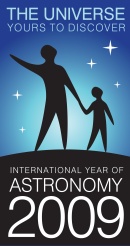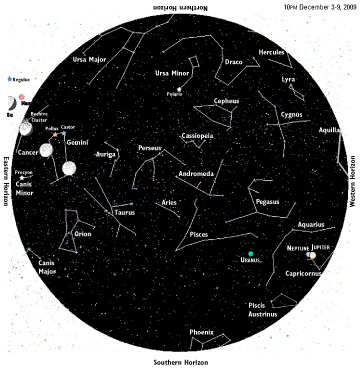Chesapeake Bay's Independent Newspaper ~ Since 1993
1629 Forest Drive, Annapolis, MD 21403 ~ 410-626-9888
Volume XVII, Issue 49 ~ December 3 - December 9, 2009
Home \\ Correspondence \\ from the Editor \\ Submit a Letter \\ Classifieds \\ Contact Us
Dining Guide \\ Home & Garden Guide \\ Archives \\ Distribution Locations \\ Advertising
![]()



Sky Watch

by J. Alex Knoll
The Zodiac’s Dimmest
There’s more to Cancer than an indistinct crab
The waning gibbous moon rises around 6pm Thursday and then falls back more than an hour each following night. Friday it shines above brilliant Procyon, the Little Dog, and below the Gemini twins Pollux and Castor.
Saturday the moon rises after 8:30 amid the stars of Cancer. Of all the zodiacal constellations, the crab is the least distinct, with its brightest star, Al Tarf, a meager fourth magnitude. Were Cancer not along the ecliptic, the path upon which the sun, moon and planets appear to travel, it would likely never have become a constellation. The greatest object of interest in Cancer is in fact no single star, but rather M44, the Beehive Cluster, which trails the moon by less than three degrees Saturday night through Sunday morning.
Visible to the unaided eye, the ancient Greeks called this cluster Praesepe, manger, and it is flanked by the northern and southern donkeys, Asellus Borealis and Asellus Australis. Today we know that, like a swarm of bees,
this cluster is made up of more than 250 stars, many of which you can discern with a good pair of binoculars.
Come Sunday, the moon sits to the lower right of Mars and to the lower left of Regulus, the heart of Leo the lion. By Monday, the moon rises around 11pm and now trails blue-white Regulus, the two of which line up with Mars higher in the sky.
In our slide toward solstice’s longest night, Monday marks a small victory in our return to light. When the sun sets at 4:43:37pm, it is the latest of the year. Don’t put away your winter gear, however, as the next day it sets all of two seconds later. While we don’t reach solstice until December 21, the earliest sunrise comes two weeks after that, all a result of earth’s elliptical orbit around the sun.
If you’re watching the sunrise this week, around 7:10, look for Venus just above the east-southeast horizon 20 or 30 minutes before dawn.
Illustration: © Copyright 1925 M.C. Escher/Cordon Art-Baarn-Holland; Graphics: © Copyright 2009 Pacific Publishers. Reprinted by permission from the Tidelog graphic almanac. Bound copies of the annual Tidelog for Chesapeake Bay are $14.95 ppd. from Pacific Publishers, Box 480, Bolinas, CA 94924. Phone 415-868-2909. Weather affects tides. This information is believed to be reliable but no guarantee of accuracy is made by Bay Weekly or Pacific Publishers. The actual layout of Tidelog differs from that used in Bay Weekly. Tidelog graphics are repositioned to reflect Bay Weekly’s distribution cycle.Tides are based on National Oceanic and Atmospheric Administration and are positioned to coincide with high and low tides of Tidelog.
© COPYRIGHT 2009 by New Bay Enterprises, Inc. All rights reserved.
